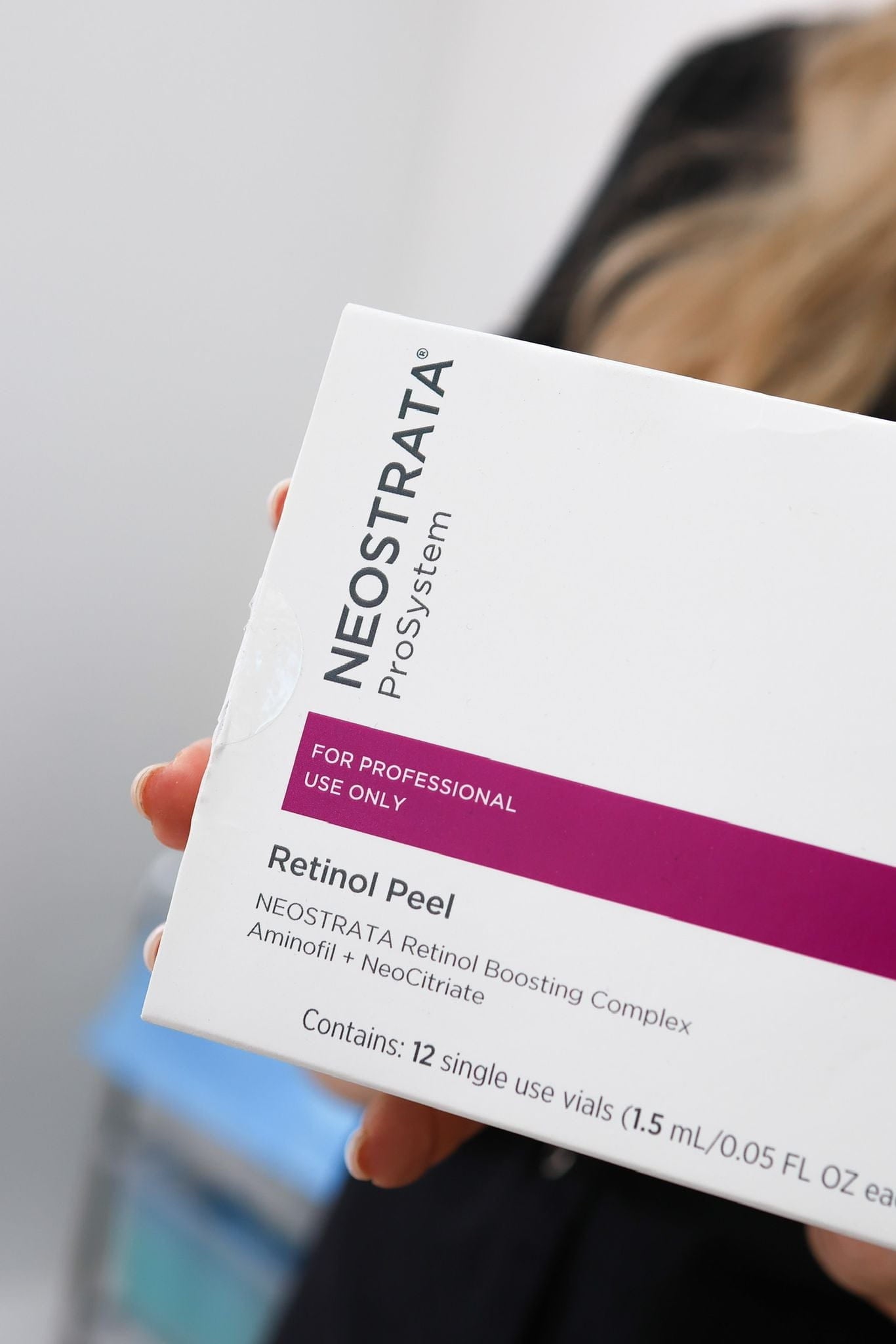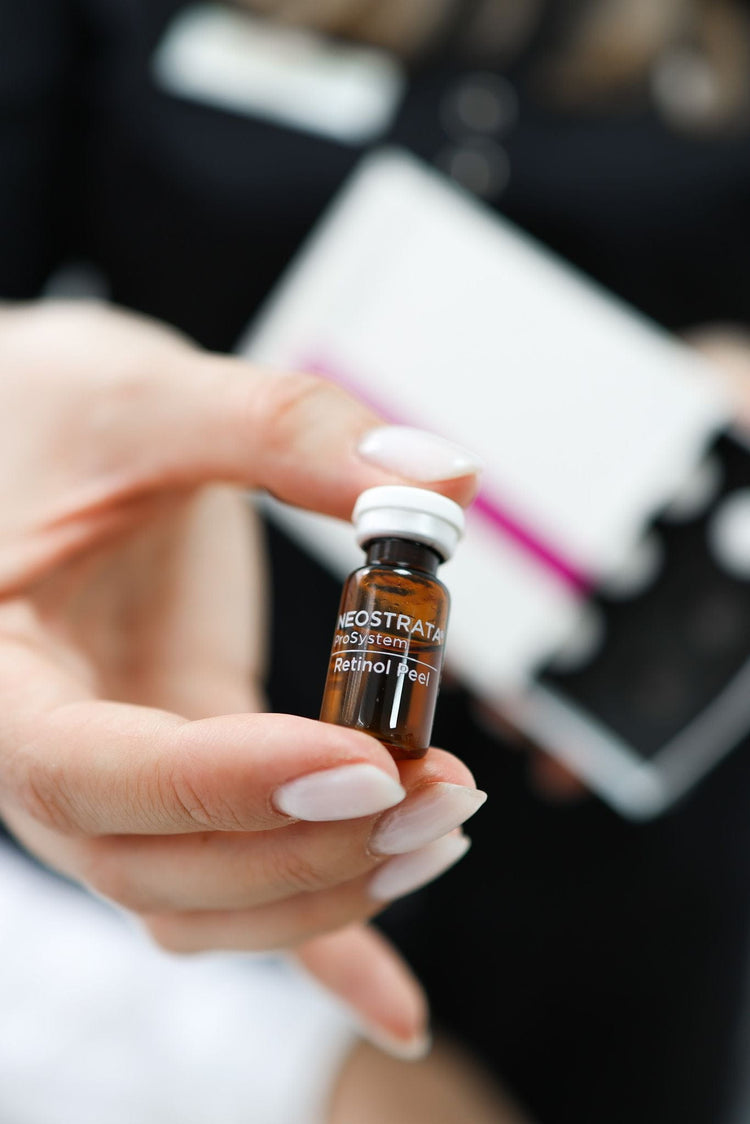How They Work
Retinol peels are a popular cosmetic treatment aimed at addressing various skin concerns, including pigmentation issues like age spots and sun spots. These peels utilize a retinoid derivative, typically retinol, which is applied to the skin and allowed to work its magic. Retinol, a form of vitamin A, boasts powerful exfoliating properties.
It penetrates the skin’s surface, promoting cell turnover and encouraging the shedding of dead skin cells. This reveals fresher, brighter skin beneath while also stimulating collagen production, which can help improve skin texture and reduce the appearance of fine lines and wrinkles. When it comes to pigmentation, retinol peels work by inhibiting melanin production, the pigment responsible for skin colour.
By reducing melanin synthesis, retinol peels can gradually lighten existing pigmented spots and prevent new ones from forming. It’s important to note that results from retinol peels are gradual and often require multiple treatments spaced weeks apart for noticeable improvements.
Different Types of Retinol Peels
There are several types of retinol peels available, each with varying strengths and formulations. One common type is the superficial peel, which uses a low concentration of retinol and penetrates only the outer layers of skin. This type of peel is generally suitable for beginners or those with sensitive skin as it has minimal downtime.
A medium-depth retinol peel utilizes a higher concentration of retinol and penetrates deeper into the skin. This type of peel can effectively address more stubborn pigmentation concerns and provide more dramatic results, but may require more downtime for recovery.
Finally, there are deep retinol peels, which use the highest concentrations of retinol and penetrate the deepest layers of skin. These peels offer the most significant results but also come with a longer recovery period and potential side effects.
Benefits of Retinol Peels for Pigmentation
Pigmentation issues like age spots and sunspots can be frustrating, impacting one’s confidence and appearance. Fortunately, advancements in cosmetic treatments offer solutions, and retinol peels have emerged as a popular option for addressing these concerns in Kingston Upon Thames.
Addressing Hyperpigmentation
Retinol peels work by inhibiting melanin production, the pigment responsible for skin colour. By reducing melanin synthesis, retinol peels can gradually lighten existing pigmented spots and prevent new ones from forming. It’s important to note that results from retinol peels are gradual and often require multiple treatments spaced weeks apart for noticeable improvements.
There are several types of retinol peels available, each with varying strengths and formulations. One common type is the superficial peel, which uses a low concentration of retinol and penetrates only the outer layers of skin. This type of peel is generally suitable for beginners or those with sensitive skin as it has minimal downtime.
A medium-depth retinol peel utilizes a higher concentration of retinol and penetrates deeper into the skin. This type of peel can effectively address more stubborn pigmentation concerns and provide more dramatic results, but may require more downtime for recovery.
Finally, there are deep retinol peels, which use the highest concentrations of retinol and penetrate the deepest layers of skin. These peels offer the most significant results but also come with a longer recovery period and potential side effects.
Reducing Sunspots and Freckles
Retinol peels can be an effective treatment for pigmentation issues such as sun spots and freckles. They work by inhibiting melanin production, which is responsible for giving skin its color.
By reducing melanin synthesis, retinol peels gradually lighten existing pigmented spots and prevent new ones from forming. It’s important to remember that results are gradual and typically require a series of treatments spaced weeks apart for noticeable improvements.
The strength of the retinol peel will determine the depth of penetration into the skin and the intensity of the results. Superficial peels, which use low concentrations of retinol, are suitable for beginners or those with sensitive skin as they have minimal downtime. Medium-depth peels offer more dramatic results but may require more recovery time.
Deep peels, using high concentrations of retinol, provide the most significant improvements but also come with a longer recovery period and a higher risk of side effects.
Evening Skin Tone
Retinol peels can be an effective treatment for pigmentation issues such as sun spots and freckles. They work by inhibiting melanin production, which is responsible for giving skin its color. By reducing melanin synthesis, retinol peels gradually lighten existing pigmented spots and prevent new ones from forming.
It’s important to remember that results are gradual and typically require a series of treatments spaced weeks apart for noticeable improvements.
The strength of the retinol peel will determine the depth of penetration into the skin and the intensity of the results. Superficial peels, which use low concentrations of retinol, are suitable for beginners or those with sensitive skin as they have minimal downtime. Medium-depth peels offer more dramatic results but may require more recovery time.
Deep peels, using high concentrations of retinol, provide the most significant improvements but also come with a longer recovery period and a higher risk of side effects.

Skin Type
Retinol peels can be an effective treatment for pigmentation issues such as sun spots and freckles.
They work by inhibiting melanin production, which is responsible for giving skin its color. By reducing melanin synthesis, retinol peels gradually lighten existing pigmented spots and prevent new ones from forming. It’s important to remember that results are gradual and typically require a series of treatments spaced weeks apart for noticeable improvements.
The strength of the retinol peel will determine the depth of penetration into the skin and the intensity of the results. Superficial peels, which use low concentrations of retinol, are suitable for beginners or those with sensitive skin as they have minimal downtime. Medium-depth peels offer more dramatic results but may require more recovery time.
Deep peels, using high concentrations of retinol, provide the most significant improvements but also come with a longer recovery period and a higher risk of side effects.
Potential Side Effects
Retinol peels offer several benefits for addressing pigmentation concerns. They work by inhibiting melanin production, the pigment responsible for skin color. This can gradually lighten existing pigmented spots like age spots and sunspots while also preventing new ones from forming.
Potential side effects of retinol peels include redness, peeling, dryness, and sensitivity. These are usually temporary and subside within a few days to a week. In some cases, more serious side effects like infection or scarring may occur, particularly with deeper peels.
Consult a Dermatologist
## Finding a Dermatologist in Kingston Upon Thames
Retinol peels offer several benefits for addressing pigmentation concerns. They work by inhibiting melanin production, the pigment responsible for skin color. This can gradually lighten existing pigmented spots like age spots and sunspots while also preventing new ones from forming.
Potential side effects of retinol peels include redness, peeling, dryness, and sensitivity. These are usually temporary and subside within a few days to a week. In some cases, more serious side effects like infection or scarring may occur, particularly with deeper peels.
If you’re considering retinol peels for pigmentation concerns in Kingston Upon Thames, consulting a dermatologist is crucial. They can assess your skin type, the severity of your pigmentation issues, and advise on the most appropriate peel type and treatment plan.
To find a dermatologist in Kingston Upon Thames, you can try searching online directories like NHS Choices or private healthcare provider websites. You can also ask for recommendations from friends, family, or your GP.
Reputable Clinics and Specialists
Retinol peels offer several benefits for addressing pigmentation concerns. They work by inhibiting melanin production, the pigment responsible for skin color. This can gradually lighten existing pigmented spots like age spots and sunspots while also preventing new ones from forming.
Potential side effects of retinol peels include redness, peeling, dryness, and sensitivity. These are usually temporary and subside within a few days to a week. In some cases, more serious side effects like infection or scarring may occur, particularly with deeper peels.
If you’re considering retinol peels for pigmentation concerns in Kingston Upon Thames, consulting a dermatologist is crucial. They can assess your skin type, the severity of your pigmentation issues, and advise on the most appropriate peel type and treatment plan. To find a dermatologist in Kingston Upon Thames, you can try searching online directories like NHS Choices or private healthcare provider websites. You can also ask for recommendations from friends, family, or your GP.
Maintenance and Aftercare
Pigmentation issues like age spots and sunspots are common concerns that can impact one’s confidence and appearance. Luckily, advancements in cosmetic treatments offer solutions, with retinol peels emerging as a popular option in Kingston Upon Thames.
Post-Peel Care Instructions
Post-peel care is crucial for optimal results and minimizing potential side effects. Your dermatologist will provide specific instructions tailored to the type and strength of retinol peel you receive.
However, some general post-care tips include:
• Gently cleanse your skin with a mild cleanser twice daily. Avoid scrubbing or harsh exfoliants.
• Apply a soothing moisturizer several times a day to keep your skin hydrated.
• Protect your skin from the sun diligently by wearing broad-spectrum sunscreen with an SPF of 30 or higher, even on cloudy days.

• Avoid picking or scratching any peeling skin, as this can increase the risk of scarring or infection.
• Stay hydrated by drinking plenty of water to support your skin’s healing process.
It is important to avoid certain activities for a period after the peel. Your dermatologist will advise on when it is safe to engage in activities like swimming, sweating, and using harsh skincare products.
Protecting Your Skin from the Sun
Protecting your skin from the sun is essential, especially after undergoing any cosmetic procedure like retinol peels.
Retinol peels can make your skin more sensitive to sunlight, increasing the risk of sunburn and hyperpigmentation.
Therefore, it’s crucial to diligently apply broad-spectrum sunscreen with an SPF of 30 or higher every day, even on cloudy days.
Ongoing Skincare Routine
Retinol peels are a popular choice for addressing pigmentation issues like sunspots and age spots. They work by inhibiting melanin production, the pigment responsible for skin color. This leads to gradual lightening of existing pigmented areas and prevents new ones from forming.
However, retinol peels can cause some side effects like redness, peeling, dryness, and sensitivity. These are usually temporary and subside within a few days to a week. In some cases, more serious side effects like infection or scarring may occur, especially with deeper peels. It’s important to consult with a dermatologist before undergoing any peel treatment. They can assess your skin type, the severity of your pigmentation concerns, and recommend the most suitable type and strength of retinol peel for you.
Post-peel care is crucial for optimal results and minimizing side effects. Your dermatologist will provide specific instructions tailored to your treatment, but some general tips include:
* Gently cleanse your skin with a mild cleanser twice daily. Avoid scrubbing or harsh exfoliants.
* Apply a soothing moisturizer several times a day to keep your skin hydrated.
* Protect your skin from the sun diligently by wearing broad-spectrum sunscreen with an SPF of 30 or higher, even on cloudy days.
* Avoid picking or scratching any peeling skin, as this can increase the risk of scarring or infection.
* Stay hydrated by drinking plenty of water to support your skin’s healing process.
Remember to follow your dermatologist’s instructions carefully and attend all follow-up appointments for optimal results and to monitor for any potential complications.
- How Often Lip Filler Top Up - August 27, 2025
- How Nasolabial Fold Fillers Work To Smooth And Soften Facial Lines In London - August 26, 2025
- How Marionette Lines Fillers Target Deep Wrinkles Around The Mouth In Kingston Upon Thames - August 23, 2025
